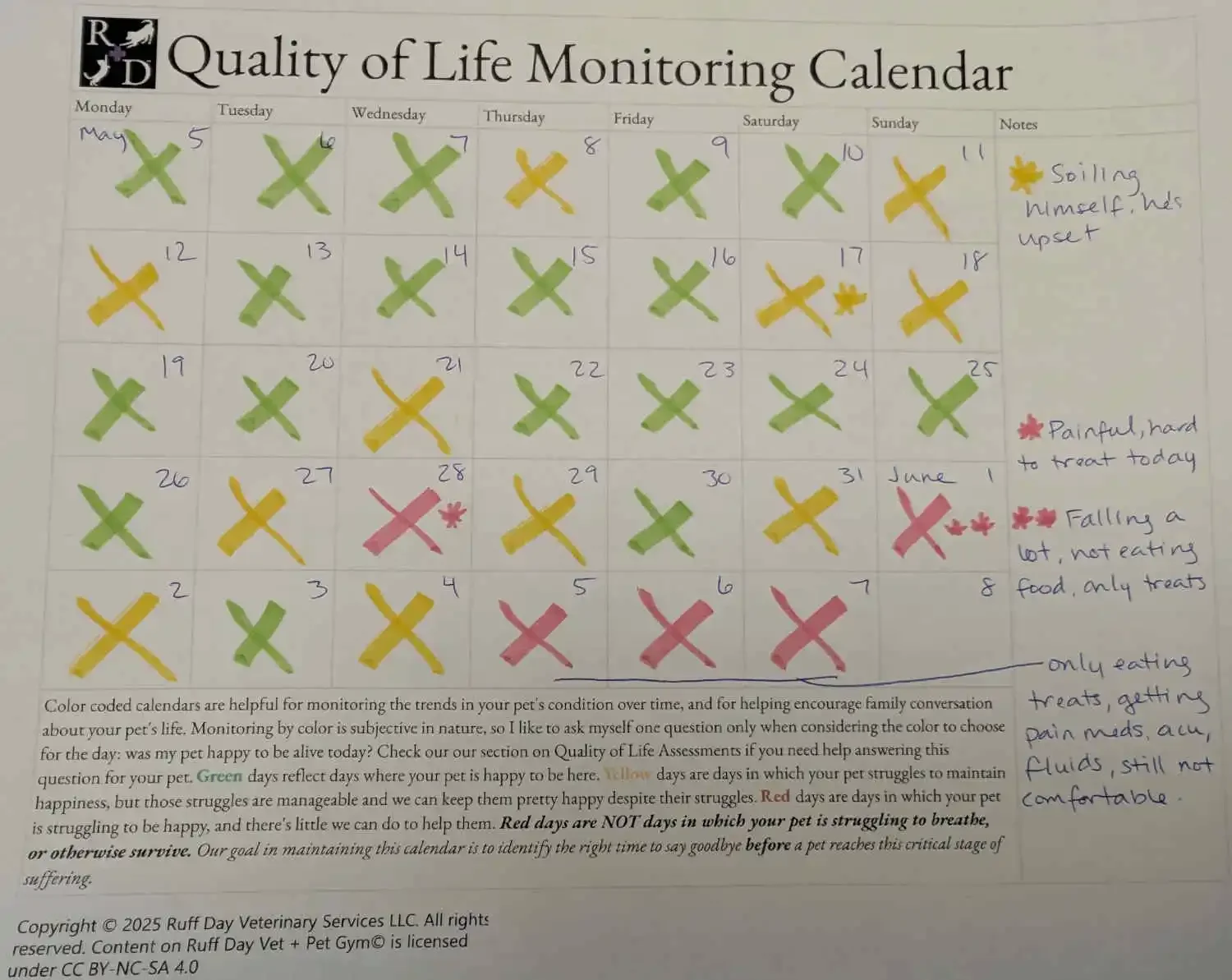Navigating End-of-Life: Your Pet's Quality of Life Calendar for Compassionate Decisions
As a veterinarian and, most importantly, as a pet parent who has navigated the tender waters of saying goodbye, I understand the immense love and the profound questions that arise when your cherished companion reaches their golden years or faces a challenging illness. This journey can feel incredibly isolating, filled with uncertainty about their comfort, their joy, and that most difficult question of all: "When is it time?" My heart goes out to you, and I want to share a tool that brought me clarity and comfort during my own precious Ralphie's final months, and that I've since shared with countless families.
A Personal Compass: How This Calendar Guided Ralphie's Journey
My personal path to integrative veterinary medicine was profoundly shaped by my beloved senior dog, Ralphie. As his chronic pain and organ problems progressed, I desperately aspired to be the doctor who could truly understand and guide him. Even for a veterinarian, assessing his day-to-day comfort became a difficult, subjective challenge. It was in those moments that the need for a clearer lens became so evident.
This very calendar emerged from that personal journey. It became my way to bring objective clarity to a subjective, emotional experience—a gentle, daily check-in that helped me see patterns I might otherwise miss. It wasn't about dictating a timeline, but about truly listening to Ralphie, day by day, and ensuring his peace was always paramount. It ultimately guided me, with love and certainty, to know when it was truly time to say goodbye before his suffering became overwhelming.
The Color-Coded Calendar: Simple Clarity for Complex Days
I’ve found that color-coded calendars are incredibly helpful for monitoring the trends in your pet's condition over time, and for helping encourage family conversation about your pet's life. While monitoring by color is beautifully subjective in nature—because every pet's happiness is unique—I guide families to ask themselves just one simple question when considering the color to choose for the day: "Was my pet happy to be alive today?" This single question helps us tap into their true essence of joy. We are honored to help many navigate this delicate time, providing support and guidance when it is most needed.
How to Use Your Calendar: A Day-by-Day Assessment
Using your calendar is designed to be straightforward and reflective, not a chore. Each day, with minimal thinking, simply ask yourself that single, powerful question: "Was my pet happy to be alive today?" I strongly encourage this to be a brief check-in with all of the caretakers involved in your pet’s care. Adam and I took this opportunity to have 30-60 seconds every day where we both reflected on challenges experienced by us or by Ralphie, discussed how to mitigate those challenges, and then agree on a color assignment for that day based on our brief discussion.
Then, using one of three colored markers or pens, you'll mark the day's box. Over time, these daily entries will allow you to quickly and visually spot important trends in your pet's well-being, providing objective clarity for a very subjective shared experience of their suffering or comfort.
Green days: These reflect days where your pet is truly happy to be here. They are engaged, comfortable, and enjoying life's simple pleasures.
Yellow days: These are days in which your pet struggles a bit to maintain happiness, but those struggles feel manageable. We can keep them pretty happy despite their challenges, and their joy still shines through.
Red days: These are days in which your pet is truly struggling to be happy, and there's little we can do to help them find their comfort or joy. It's vital to understand that Red days are NOT days in which your pet is struggling to breathe, or otherwise survive. My profound goal in creating and sharing this calendar is to help us all identify the right time to say goodbye before a pet reaches this critical stage of undeniable suffering.
Beyond the Calendar: Partnering for Compassionate Guidance
This calendar is more than just a tracking tool; it's a conversation starter. The trends you observe—a growing number of red or yellow days, or a sudden shift—become incredibly valuable insights for our consultations. This objective data helps us to facilitate empathetic and informed decision-making for palliative care and, when the time is right, for those incredibly difficult euthanasia discussions. Even as our dedicated euthanasia services are anticipated for late 2025, please know that our compassionate guidance and support for this deeply emotional and personal journey are available to you now within your consultation.
Ready to Begin Your Pet's Healing Journey?
Take the first step towards a healthier, happier life for your cherished companion. Our compassionate team is ready to partner with you.
About the Author: Dr. Heather Misener, DVM
This article was crafted by Dr. Heather Misener, DVM, CCRT, CVAT, CVNN – Co-Founder, Medical Director, and Veterinarian at Ruff Day Vet. With extensive certifications in Canine Rehabilitation Therapy (CCRT), Veterinary Acupuncture (CVAT), and Veterinary Natural Nutrition (CVNN), Dr. Heather brings a profound dedication to integrative care (a holistic approach blending conventional medicine with complementary therapies). Her philosophy centers on empowering pet owners through clear education and fostering a fear-free environment (where pets are comfortable and willing participants in their care), guiding cherished companions toward lasting comfort and optimal vitality.


